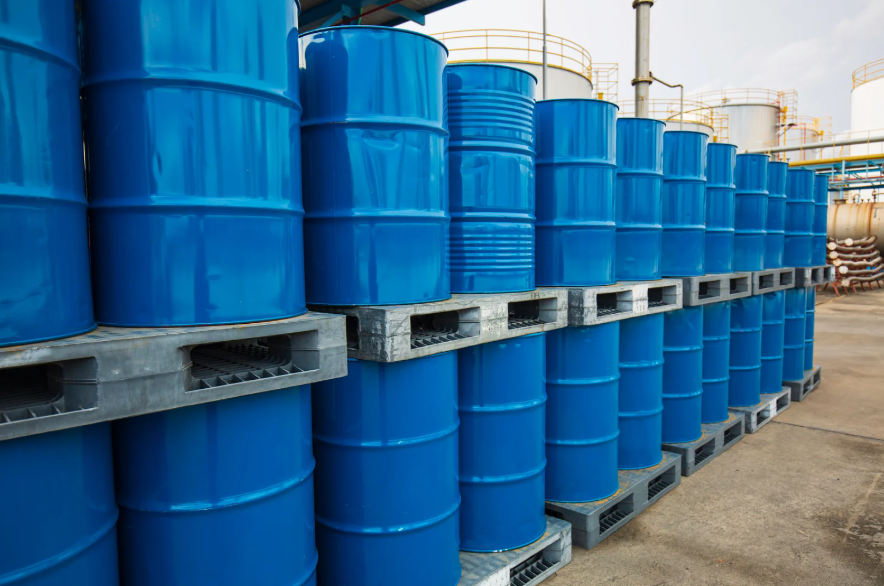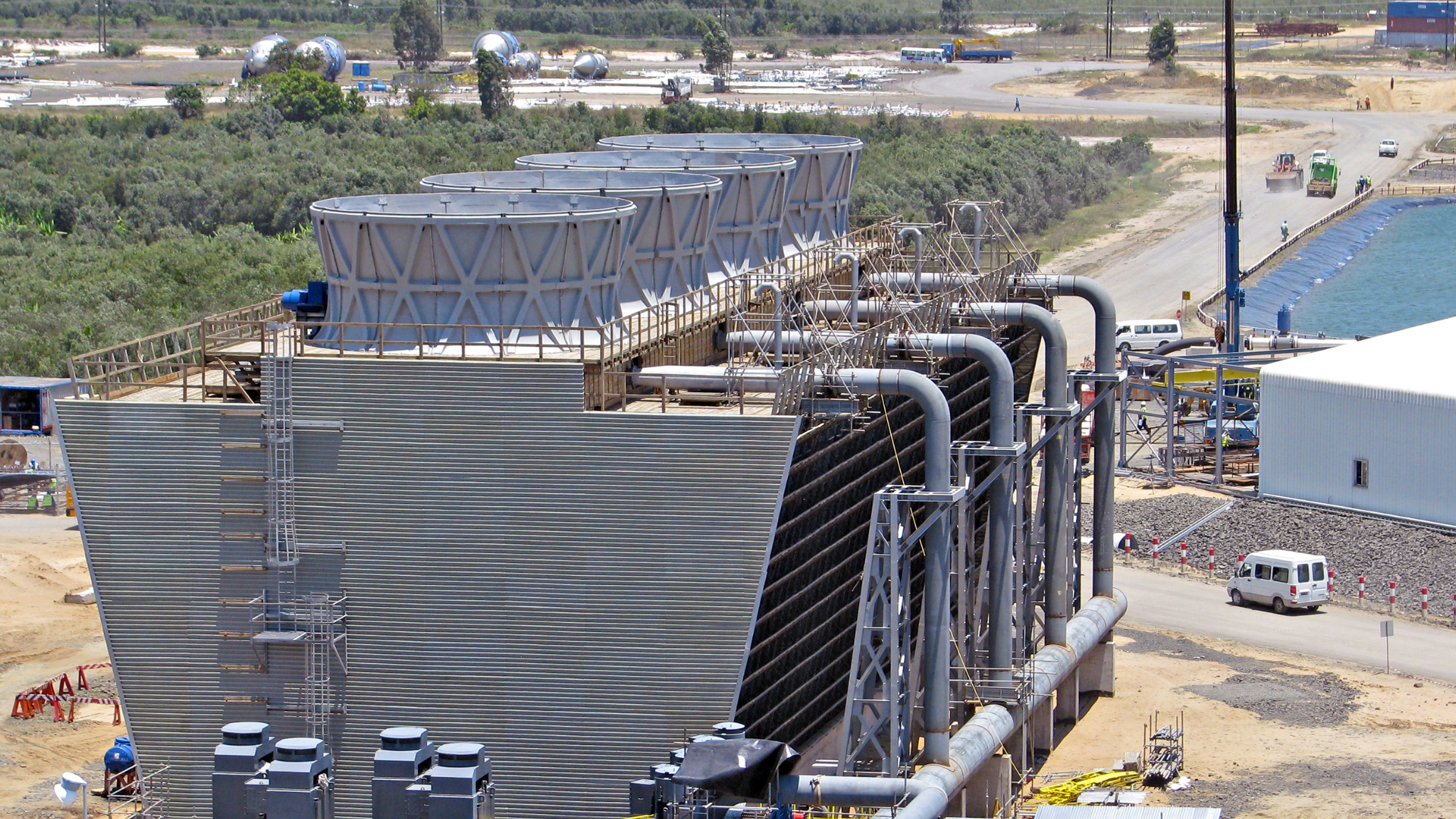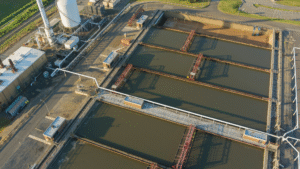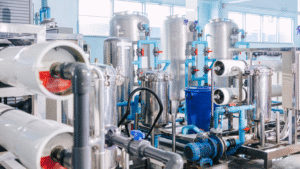In industrial and commercial operations, cooling towers play a vital role in managing heat loads and maintaining efficient process temperatures. Whether in manufacturing, power generation, or HVAC systems, these towers are responsible for dissipating heat through evaporative cooling, a process that continuously cycles water through heat exchangers and tower structures.
However, as water evaporates, it leaves behind dissolved minerals, organic material, and other contaminants that can compromise performance. Without intervention, problems like scale buildup, corrosion, and microbial growth can take hold—leading to costly equipment damage and unscheduled downtime.
This is where cooling tower chemicals become essential. These specialized formulations are used to maintain water quality, protect critical infrastructure, and ensure that the cooling tower operates at peak efficiency. In this guide, we’ll break down the most important chemicals used in cooling water treatment, how they work, and how to choose the right program for your facility.
Why Chemical Treatment Is Critical for Cooling Towers
Cooling towers rely on the principle of evaporative cooling to remove heat from industrial or HVAC processes. As warm water flows through the tower and comes into contact with air, a small portion of the cooling water evaporates. This evaporation removes heat but also concentrates the remaining dissolved minerals in the system.
Without proper water treatment, the recirculating water can exceed its solubility limits, leading to scale formation, corrosion, and biological growth. These issues can cause a cascade of problems:
- Scale insulates heat exchange surfaces, reducing thermal performance and increasing energy costs.
- Corrosion damages metal components and shortens equipment life.
- Microbial growth, such as biofilms or algae, can obstruct water flow and increase the risk of equipment failures.
Because most cooling towers reuse the same water repeatedly, these contaminants accumulate over time unless managed through effective cooling tower chemical treatment. Treating the water ensures that heat exchangers remain clean, system efficiency is maintained, and unexpected downtime is minimized.
Whether it’s for heavy industry or commercial buildings, cooling tower water treatment is a necessity to protect capital assets and avoid significant issues from left uncontrolled water quality.
Types of Cooling Tower Chemicals and Their Functions

Effective cooling tower water treatment relies on a carefully balanced chemical program. Each chemical plays a specific role in protecting the system, improving equipment life, and maintaining water quality. Below are the most common categories of cooling tower chemicals, along with how they function.
1. Scale Inhibitors and Polymeric Dispersants
Scale formation is one of the most common problems in cooling tower systems. As water evaporates, minerals like calcium carbonate and other calcium salts become more concentrated. When the concentration exceeds solubility limits, these compounds precipitate and form hard deposits on heat transfer surfaces.
Scale inhibitors work by interfering with crystal growth, delaying or preventing the formation of solid scale. Polymeric dispersants keep suspended solids from settling by dispersing particles throughout the recirculating water, preventing buildup on pipes and heat exchangers.
Key benefits:
- Prevents scale on surfaces that reduce heat transfer efficiency
- Allows higher cycles of concentration, reducing make up water demand
- Helps manage water hardness without overusing softeners
2. Corrosion Inhibitors
Cooling towers contain a range of metal components including steel, copper, and galvanized parts. When untreated water flows through these areas, it can cause corrosion, leading to leaks, thinning walls, and corrosion products that foul other parts of the system.
Corrosion inhibitors create a protective film on metal surfaces. This barrier minimizes oxidation reactions that cause damage and helps extend the lifespan of cooling tower water infrastructure.
Types include:
- Phosphate-based inhibitors for general systems
- Azole compounds for copper alloys
- Zinc-based inhibitors in high-demand conditions
3. Biocides: Controlling Microbiological Activity
Microbial growth in towers poses health risks and operational challenges. Bacteria, algae, and fungi can multiply rapidly in warm, nutrient-rich cooling water, forming biofilms that insulate surfaces and accelerate corrosion.
There are two main types of biocides used in cooling tower chemical treatment:
- Oxidizing biocides: These include agents like sodium hypochlorite, which destroy microorganisms by breaking down their cell walls. They act quickly and are effective in low concentrations.
- Non oxidizing biocides: These target specific organisms through enzyme disruption or membrane interference. They are often used when oxidizers are less effective or to supplement an existing biocide program.
Maintaining an alternating biocide schedule improves results and reduces the risk of microbial resistance, supporting overall system efficiency.
Read more on our blog: The Hidden Costs of Poor Cooling Tower Chemical Treatment: A Chemical Blender’s Perspective
How Proper Dosing and Control Systems Enhance Results
Even the best cooling tower chemicals cannot perform effectively without accurate dosing and control. Chemical underfeeding leads to problems like scale formation and microbiological growth, while overfeeding results in wasted product and increased discharge concerns.
Automated systems help maintain the correct balance by continuously monitoring parameters such as pH levels, conductivity, and oxidation-reduction potential (ORP). These measurements guide dosing pumps to adjust chemical feed in real time, ensuring consistent treatment.
Key benefits of automated control systems include:
- Maintaining target concentration levels for scale and corrosion inhibitors
- Ensuring stable biocide performance against bacterial or algal outbreaks
- Adjusting for fluctuations in make up water quality and evaporated water volumes
- Reducing human error and manual intervention
In many systems, raising the cycles of concentration reduces overall water usage. However, this also increases the concentration of dissolved minerals, requiring more precise treatment to avoid exceeding solubility limits. With well-calibrated control systems, operators can safely run at higher cycles while minimizing risk.
How ETI Supports Your Cooling Tower Water Treatment Strategy
At ETI, we recognize that effective cooling tower chemical treatment is about more than just the right product. It’s also about delivering integrated solutions that ensure system efficiency, extend equipment life, and protect your facility from operational risks.
Our treatment programs are built around high-performance cooling tower chemicals designed to address the full spectrum of issues: scale formation, corrosion, and microbiological growth. We combine this chemistry with real-world technical knowledge and application support for long-term results.
Solutions Backed by Advanced Chemistry
- Scale and deposit control: Our phosphonate-based technologies and polymeric dispersants inhibit crystal growth, stabilize dissolved minerals, and support higher cycles of concentration.
- Corrosion protection: Multi-metal inhibitors and azole technologies defend against corrosion products and safeguard diverse metal components.
- Biological control: From oxidizing biocides like sodium hypochlorite to targeted non oxidizing biocides, our microbiological control programs disrupt biofilm, reduce microbial growth, and ensure compliance.
Expertise That Drives Results
Whether your facility operates under challenging make up water conditions or has specialized compliance needs, ETI’s custom-blended programs are formulated to adapt. Our team conducts thorough system assessments, supports automated systems integration, and offers training to ensure your staff is confident in treatment monitoring and performance adjustments.
If you want to learn more about ourCooling Tower Chemical Treatment Solutions or explore our full line of Biocides for microbial control, we invite you to connect with our team.
Achieving Long-Term Performance with the Right Chemicals
Cooling towers remain essential across many industries, supporting efficient process cooling and thermal regulation. However, without the right chemical treatment strategy, even well-designed cooling systems can suffer from costly equipment damage, microbiological activity, and scaling that undermines heat transfer.
Using the correct mix of cooling tower chemicals is an effective method for ensuring consistent performance. When a cooling tower operates with balanced chemistry, it maximizes efficiency, minimizes downtime, and extends equipment life, regardless of whether it’s dealing with scale, corrosion, or other contaminants.
For facilities seeking long-term value, tower chemical treatment is more than a maintenance task. It’s a proactive investment in asset protection, water conservation, and system reliability. if you want smart treatment programs, cooling tower systems that can safely recycle the same water, reduce evaporated water loss, and support safe operations for years to come, contact us today.
Frequently Asked Questions
What are tower chemicals and why are they important?
Tower chemicals refer to the specific blend of treatment products used in cooling towers to manage scale, corrosion, and microbiological growth. They are essential to preserving system performance, protecting infrastructure, and supporting water efficiency.
How does evaporated water affect cooling tower performance?
As evaporated water leaves the system, it concentrates the remaining dissolved solids. This increases the risk of scale formation, fouling, and corrosion if not balanced with proper make up water and chemical control.
Do cooling tower chemicals come in various forms?
Yes, cooling tower chemicals are available in various forms including liquids, powders, and tablets. Selection depends on dosing requirements, storage space, and safety protocols. ETI offers flexible chemical formats to suit different system designs.
Can the same water be reused in a cooling tower system?
Absolutely. Most cooling towers reuse the same water in a recirculating system. However, without appropriate tower chemical treatment, reuse can lead to accumulation of dissolved minerals, microbiological activity, and other contaminants.





